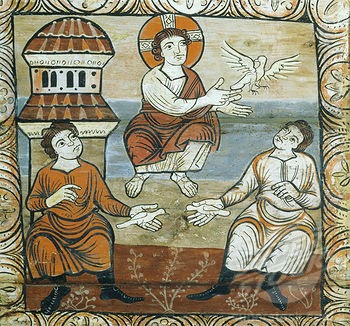Not to be confused with the better-known Gospel of Thomas, which is a more explicitly Gnostic text from the first or second century composed mainly of supposed aphorisms of Christ, the Infancy Gospel of Thomas (probably composed around the same time as the Proto-Gospel of James, in the second century) is a purported narrative of Christ’s childhood years. The original Greek text is structured around a set of miracles and attempts at educating the Christ Child. Claiming to be written by “Thomas the Israelite Philosopher,” the Infancy Gospel gives us a five year-old boy “Jesus” who is fickle, vain, and flagrantly powerful. I’m going to call this bizarro-Christ “Hermus,” due to his similarities to the stories of the infant pagan deity Hermes, and the book’s apparent ties to the Hermetic-Gnostic tradition.
Most people have heard the apocryphal stories of the young Christ frivolously creating birds out of clay, and killing other young boys who offended him. These stories apparently originate in the Infancy Gospel of Thomas, and they are even more blasphemous than you might imagine. Hermus is sort of a divine snot. He bores easily, performs miracles mostly to pass the time, and gets offended when someone undoes his work, often killing them. Occasionally Hermus will use his supernatural powers to cure an illness or injury, or even to raise the dead, but this seems to be a product of whimsy rather than concern.
The Gnostic elements come into play when Hermus is sent off to tutors to learn his letters. In a perverse inversion of St. Luke’s account of Jesus speaking with the learned men in the Temple, Hermus lectures his own teachers obnoxiously about the letter A, humiliating them and ruining their reputations. His first teacher Zacchæus declares, “That child does not belong to this earth. Assuredly he was born before the creation of the world” (7). When Zacchæus’ friends attempt to reassure him of his learning, Hermus mocks them openly: “Now let your learning bring forth fruit, and let the blind in heart see. I am here from above, that I may curse them, and call them to the things that are above” (8).
Joseph is a constant figure in this Infancy Gospel. He is frequently put out by Hermus’ behavior, chastising the boy for his flippant disregard for human life and social mores. When Joseph pulls the boy’s ear for cursing another boy to death (5), Hermus is angry at receiving the punishment, but never retaliates against his stepfather. In fact, Hermus’ piety towards Joseph is a bizarre paradox when contrasted with the poor way he disposes of his teachers.
The most important episode with Joseph is also probably the first depiction of Christ in Joseph’s carpentry shop, and is worth quoting in its entirety:
And His father was a carpenter, and at that time made ploughs and yokes. And a certain rich man ordered him to make him a couch. And one of what is called the cross pieces being too short, they did not know what to do. The child Jesus said to His father Joseph: Put down the two pieces of wood, and make them even in the middle. And Joseph did as the child said to him. And Jesus stood at the other end, and took hold of the shorter piece of wood, and stretched it, and made it equal to the other. And His father Joseph saw it, and wondered, and embraced the child, and blessed Him, saying: Blessed am I, because God has given me this child. (13)It might not be too much of a stretch to find hidden beneath the literal narrative an implication of the Gnostic doctrine that Christ came to overcome a corrupted creation. The piece of wood Joseph wishes to use is of the wrong length, and rather than let his stepfather seek out another piece (the natural method), Hermus simply remakes the piece into the way they need it to be (a cheating of the natural process).
Joseph’s insistence that Hermus be well-tutored is probably also tied to Gnostic doctrines. He is simply ignorant of the fact that Hermus came to earth to teach rather than to be taught. The later Latin version of the Infancy Gospel shows Joseph giving thanks to God after leaving Egypt, “because He had given him understanding” (L.3). The Gnostic doctrine of salvation through knowledge appears to be on display in these passages.
St. James the Just appears for one miraculous episode, as well:
And Joseph sent his son James to tie up wood and bring it home, and the child Jesus also followed him. And when James was gathering the fagots, a viper bit James’ hand. And when he was racked with pain, and at the point of death, Jesus came near and blew upon the bite; and the pain ceased directly, and the beast burst, and instantly James remained safe and sound. (16)All in all, we learn little about the real St. Joseph in the Infancy Gospel of Thomas, but there is corroborating evidence here that the early Christians believed him to have had other children. There seems to be no mention of his age, unless there is a subtlety of the Greek text that was lost in translation. Any suggestions of Joseph’s poor moral quality should be taken with the caveat that even the Christ Child is depicted amorally. (Apocryphal ravings, indeed!)
For those curious, Mary is a minor background figure in this book, for the most part, doing little but keeping Hermus in check while Joseph is away.
Next time, I will continue to look at the odd ways in which these two traditions, one orthodox and one heterodox, were clumsily merged into longer narratives of the “lost years” of Our Lord and St. Joseph.
 |
| St. Joseph the carpenter who knew how to cut lumber, pray for us! |



This comment has been removed by the author.
ReplyDeleteThis comment has been removed by the author.
ReplyDelete